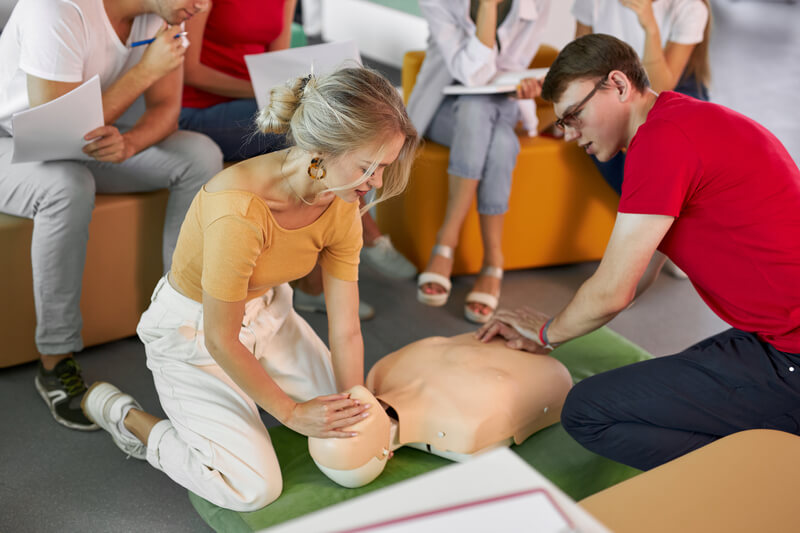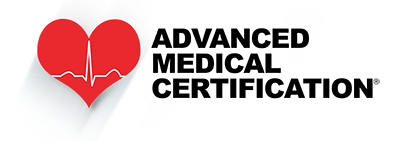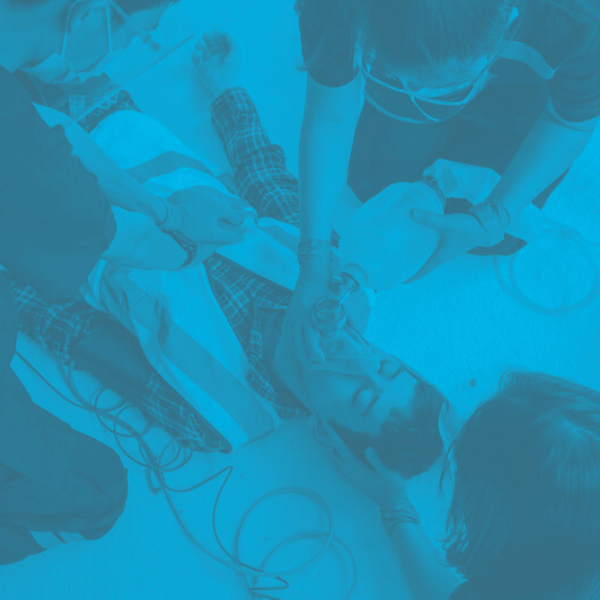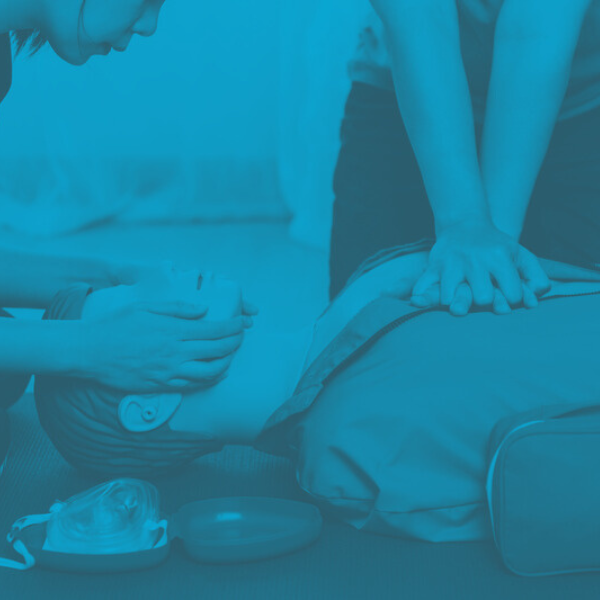What is a BLS Certification & When to Take a BLS Class?
What is a BLS Certification & When to Take a BLS Class?

by Greta Kviklyte
Life Saver, AMC
Co-authored by Kim Murray, RN, M.S.
posted on Sep 29, 2025, at 1:59 am
Basic Life Support (BLS) certification is a credential that proves you’ve been trained to respond quickly and effectively during life-threatening emergencies. It covers essential skills like performing first aid, high-quality CPR, using an automated external defibrillator (AED), and relieving airway obstructions in adults, children, and infants.
This certification matters because, in any situation, having trained responders nearby can double or even triple a person’s chance of surviving sudden cardiac arrest. It is especially important for professionals who work directly with patients or in emergency response roles, including doctors, nurses, paramedics, EMTs, respiratory therapists, medical students, and clinical interns. First responders like firefighters and police officers also rely on basic life support training, as do caregivers, physical therapists, and others responsible for taking care of vulnerable populations.
We offer Online CPR and BLS Certification
What Does BLS Mean in Medical Terms?
In medicine, BLS describes a set of essential emergency procedures used to sustain life when a patient is in cardiac arrest, respiratory failure, or has a blocked airway. It is the foundation of resuscitation care, grounded in internationally recognized guidelines such as those published by ILCOR.
The goal of BLS is to keep oxygenated blood flowing to the brain and vital organs until advanced medical care can take over. That is done using medical skills such as high-quality CPR, delivering effective rescue breaths, and using an AED to restore a normal heart rhythm.
While BLS is required training for healthcare providers, these skills are just as vital in schools, fitness centers, workplaces, and homes, since these are the places most out-of-hospital cardiac arrests occur.
 When is BLS Certification Required in Healthcare Roles
When is BLS Certification Required in Healthcare Roles
BLS certification is considered a baseline requirement across most clinical and emergency care professions. It ensures that anyone providing patient care has the ability to respond immediately to cardiac or respiratory emergencies. Here’s where it’s most often required:
Nurses (RNs, LPNs, CNAs)
From intensive care units to long-term care facilities, nurses are frequently the first to notice when a patient goes into cardiac or respiratory arrest. Because of their proximity to patients, most employers require registered nurses, licensed practical nurses, and certified nursing assistants to maintain current BLS certification.
Doctors and Medical Residents
Physicians and allied health professionals, including physician assistants and advanced practice clinicians, must hold valid BLS certification to meet hospital credentialing standards. Medical residents in training are also expected to have BLS certification before they begin clinical rotations.
Rehabilitation and Respiratory Therapists
Occupational therapists, physical therapists, and respiratory therapists may not be emergency specialists, but they regularly work with vulnerable populations in rehab gyms, outpatient clinics, and respiratory therapy units.
Paramedics and EMTs
For emergency medical technicians, their entire role is built on providing life-saving care during the critical minutes before hospital arrival.
Medical Students & Interns
Students preparing for clinical placements, hospital internships, or hands-on patient care are typically required to earn BLS certification as part of their onboarding. This ensures they can provide safe, effective care alongside supervising clinicians.
CPR vs BLS: Are They the Same Thing?
It’s easy to confuse CPR certification with BLS certification, since both involve lifesaving techniques. However, they serve different purposes and are designed for different audiences.
- CPR (Cardiopulmonary Resuscitation) certification focuses on chest compressions and rescue breathing to keep blood and oxygen circulating until professional help arrives. It’s often combined with training on how to use an AED.
- Basic life support includes CPR and AED while also covering team-based resuscitation, airway management, relief of choking, and responding to emergencies in infants, children, and adults.
Who Needs CPR vs. BLS Training
CPR certification is ideal for teachers, coaches, fitness instructors, lifeguards, parents, or anyone who wants to be prepared to help in public or home emergencies.
BLS certification is required for healthcare professionals such as nurses, doctors, paramedics, and medical students because it’s more comprehensive and clinically focused.
Key Components of BLS Training
A BLS class is designed to give you a structured, reliable framework for responding in life-threatening emergencies. While the course is comprehensive, several core elements form the foundation of what you’ll practice and master.
The 3 C’s of BLS: Check, Call, Compress
- Check the victim for responsiveness and breathing.
- Call for help and activate emergency services.
- Compress the chest with high-quality CPR to keep oxygenated blood flowing until advanced care arrives.
Airway Management
Properly opening and maintaining a clear airway is essential. BLS training covers techniques such as the head-tilt, chin-lift maneuver and, when appropriate, the jaw thrust. You’ll also learn how to recognize and address airway obstructions.
Rescue Breaths
Providing effective rescue breaths varies depending on the patient’s age. Training covers the correct technique for adults, children, and infants, ensuring that oxygen is delivered safely and efficiently.
AED Usage
An Automated External Defibrillator (AED) can restore normal heart rhythm in sudden cardiac arrest. BLS courses teach you how to quickly apply AED pads, follow prompts, and deliver a shock when indicated.
Many BLS courses incorporate scenario-based simulations so you can apply skills in lifelike situations. These simulations prepare you for the stress of real emergencies so you won’t get overwhelmed.
BLS in Different Medical Environments
While the skills you learn in a basic life support course are consistent, how they’re applied depends heavily on the setting.
In-Hospital Emergencies
In hospitals, BLS is often part of rapid-response systems such as “code blue” events in emergency departments, intensive care units (ICUs), or general wards. Here, BLS skills are used as the first line of action while advanced teams and equipment are mobilized. Teams are expected to able to clearly assign roles when responding to an emergency, which means everyone knows who is responsible for compressions, rescue breaths, and using the defibrillator.
Out-of-Hospital Situations
Cardiac arrests and other emergencies often happen in homes, workplaces, or during sports events. In these scenarios, it’s great to have first responders, coaches, teachers, and even bystanders trained in BLS so they can help until EMS arrives. Out-of-hospital BLS may mean improvising with limited resources, but the response remains the same.
Pediatric vs. Adult Protocols
Children and infants require special modifications in BLS. Compression depth, rescue breath volume, and hand placement all differ in pediatric patients compared to adults, so it’s important to know pediatric-specific protocols.
Types of BLS Training
Online training is the most flexible option, allowing you to work through the material at your own pace from anywhere. Getting your BLS certification online is especially appealing to busy professionals or students looking for a BLS training provider. AMC’s courses are accredited by the Postgraduate Institute for Medicine (PIM) and meet all current ILCOR guidelines.
In-person classroom training remains the traditional choice. Learners get to have live instruction, hands-on practice with manikins, and immediate feedback from certified trainers. This format is ideal for those who want direct supervision, but it does require committing to a fixed schedule and traveling to a training center.
Blended learning allows students to complete theory modules online and then attend a shorter, in-person skills session to demonstrate competence. This format provides flexibility without sacrificing the confidence that comes from practicing under an instructor’s guidance.
When deciding which format is best, your schedule and career demands make a big difference. For busy healthcare professionals like nurses, EMTs, and medical students, online certification offers a fast, flexible way to stay compliant without taking time away from patient care or clinical rotations. However you choose to get it, your certificate will be valid for two years, at which point you will ned a to complete a BLS renewal course.
Your Next Step in Lifesaving Skills
If you’re ready to take the next step, explore AMC’s BLS certification and recertification courses, or browse our related resources on CPR training and life support certifications.




